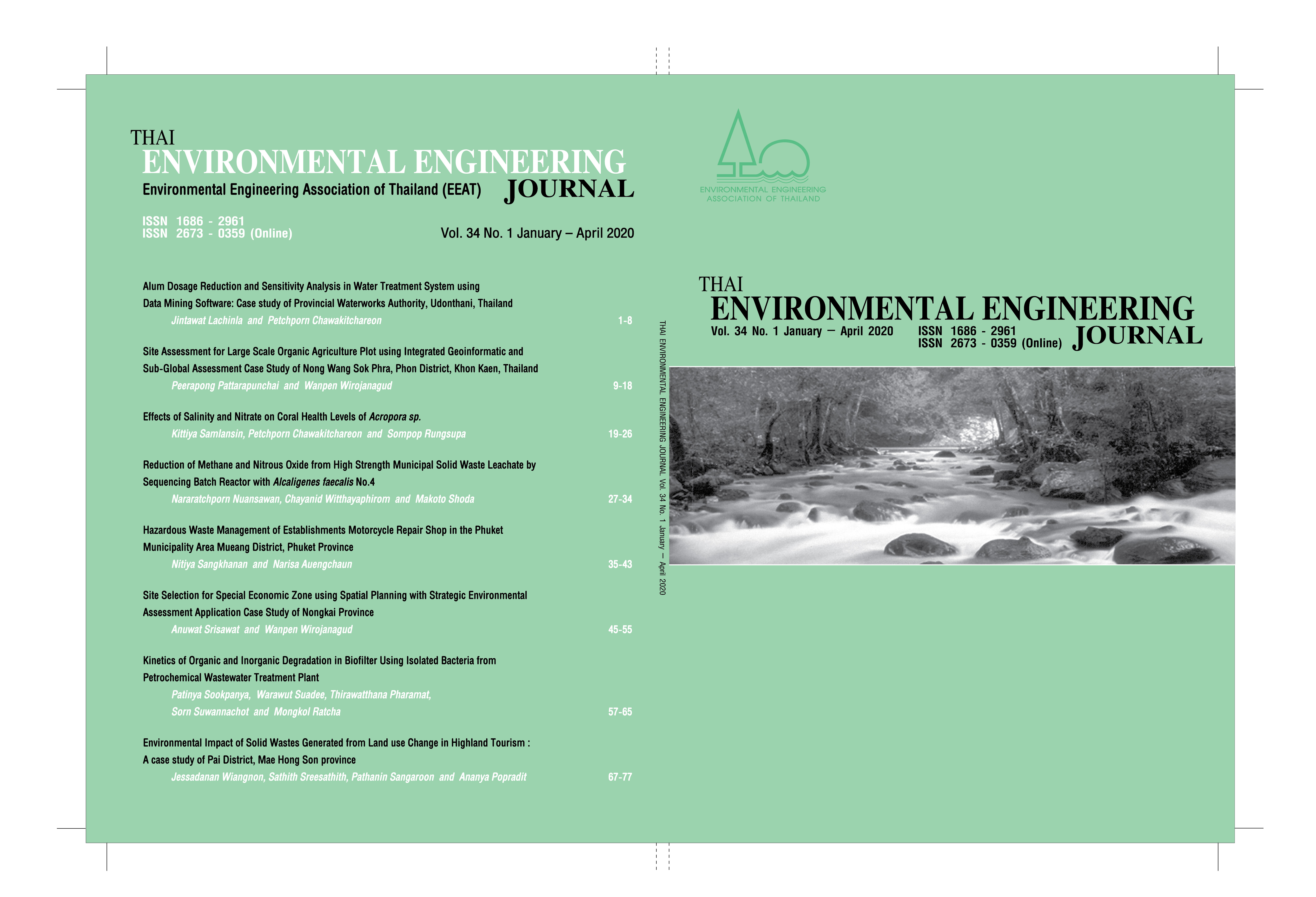Environmental Impact of Solid Wastes Generated from Land use Change in Highland Tourism : A case study of Pai District, Mae Hong Son province
Main Article Content
Abstract
Increasing amount of solid wastes due to land use change has been resulted by the intensive tourism services in Pai District, Mae Hong Son Province. It has consequently affected the ecosystem, especially in the highland area, where are natural tourist attractions. The aims of this study are: (1) to assess the environmental impact of the solid wastes generated from the generated point as well as from the disposal point, and (2) to assess the environmental impact of land use change for tourism sites in mountain areas or tourist attraction highlands, using the Geographic Information System (GIS). GIS is an assessment tool for land use planning in accordance with sustainable urban development. The study results presented that 6.07 tons/day being the amount of wastes generated by tourists of urban areas. An average of 52.25 kg/sampling spot/day generated from various hotel sizes, while an average of 66.63 kg/sampling spot/day generated from the tourist sites. There were 32 wastes disposal points, using the Trench Method, Open dump and Open burning where are spatially distributed at different areas and at different heights. Many areas are classified as sensitive areas, contamination risk areas, spreading to other nearby areas. Conclusively, if wastes management is in conformance with land use planning, legally wastes disposal to the right spots with academic performing, it would be possible to minimize the environmental impact possibly occurred in the short and long term. This could also lead to urban planning that promotes tourism while maintaining a balanced environmental and ecological status.
Article Details
References
Chaisumpunsakul, W. and Pholphirul, P. (2017). Does international trade promote international tourism demand? Evidence from Thailand's trading partners. Kasetsart Journal of Social Sciences.
Manomaivibool, P. Wasteful tourism in developing economy? A present situation andsustainable scenarios. Resources, Conservation and Recycling. 2015;103:69-76.
Kariminia, Shahab, Sabarinah, Sh. Ahmad, and Rugayah Hashim. 2012. Assessment of Antarctic Tourism Waste Disposal and Management Strategies towards a Sustainable Ecosystem. Procedia - Social and Behavioral Sciences 68: 723–34. https://linkinghub.elsevier.com/retrieve/pii/S187704281205745X.
Mutana, S. and Mukwada, G. Mountain-route tourism and sustainability. A discourse analysis of literature and possible future research. Journal of Outdoor Recreation and Tourism. 2018;24:59-65.
Azadi, S. and Karimi-Jashni, A. Verifying the performance of artificial neural network and multiple linear regression in predicting the mean seasonal municipal solid waste generation rate: A case study of Fars province, Iran. Waste Manag. 2016;48:14-23.
Bashir, S. and Goswami, S. Tourism induced challenges in municipal solid waste management in hill towns: Case of Pahalgam. Procedia Environmental Sciences. 2016;35:77-89.
Geneletti, D. and Dawa, D. Environmental impact assessment of mountain tourism in developing regions: A study in Ladakh, Indian Himalaya. Environmental Impact Assessment Review. 2009;29(4):229-42.
Keser, S., Duzgun, S. and Aksoy, A. Application of spatial and non-spatial data analysis in determination of the factors that impact municipal solid waste generation rates in Turkey. Waste Manag. 2012;32(3):359-71.
Torres-Delgado, A. and López Palomeque, F. The ISOST index: A tool for studying sustainable tourism. Journal of Destination Marketing & Management. 2018;8:281-9.
Canteiro, M., Córdova-Tapia, F. and Brazeiro, A. Tourism impact assessment: A tool to evaluate the environmental impacts of touristic activities in Natural Protected Areas. Tourism Management Perspectives. 2018;28:220-7.
Sánchez-Galiano, J-C., Martí-Ciriquián, P. and Fernández-Aracil, P. Temporary population estimates of mass tourism destinations: The case of Benidorm. Tourism Management. 2017;62:234-40.
Greco, G., Cenciarelli, VG. and Allegrini, M. Tourism's impacts on the costs of municipal solid waste collection: Evidence from Italy. Journal of Cleaner Production. 2018;177:62-8.
Jaima, W. et.al. 2015. The development of green tourism in Chiang Rai municipality foreigner tourist. Chiang Rai Rajabhat University., Chiang Rai province.
Nilnoppakun, A. and Ampavat, K. Is Pai a Sustainable Tourism Destination? Procedia Economics and Finance. 2016;39:262-9.
Natan, T. and Wattanapinyo, A. 2019. The effect of adapting to the tourism of Pga K’nyau community Ban Mae Ping, Pai district, Mae Hong Son province. Social Science Research and Academic Journal., Bangkok.
O'Reilly AM. Tourism Carrying Capacity. Concept and Issues. Tourism Management. 1986;7(4):254-8.
Swangiang, K. 2017. Environmental Assessment on the basis of sustainable development. Faculty of Science, Silpakorn University., Bangkok.


